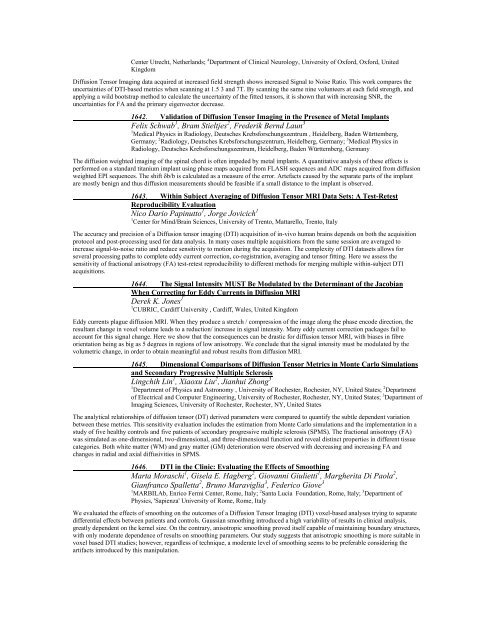Traditional Posters: Diffusion & Perfusion - ismrm
Traditional Posters: Diffusion & Perfusion - ismrm
Traditional Posters: Diffusion & Perfusion - ismrm
Create successful ePaper yourself
Turn your PDF publications into a flip-book with our unique Google optimized e-Paper software.
Center Utrecht, Netherlands; 4 Department of Clinical Neurology, University of Oxford, Oxford, United<br />
Kingdom<br />
<strong>Diffusion</strong> Tensor Imaging data acquired at increased field strength shows increased Signal to Noise Ratio. This work compares the<br />
uncertainties of DTI-based metrics when scanning at 1.5 3 and 7T. By scanning the same nine volunteers at each field strength, and<br />
applying a wild bootstrap method to calculate the uncertainty of the fitted tensors, it is shown that with increasing SNR, the<br />
uncertainties for FA and the primary eigenvector decrease.<br />
1642. Validation of <strong>Diffusion</strong> Tensor Imaging in the Presence of Metal Implants<br />
Felix Schwab 1 , Bram Stieltjes 2 , Frederik Bernd Laun 3<br />
1 Medical Physics in Radiology, Deutsches Krebsforschungszentrum , Heidelberg, Baden Württemberg,<br />
Germany; 2 Radiology, Deutsches Krebsforschungszentrum, Heidelberg, Germany; 3 Medical Physics in<br />
Radiology, Deutsches Krebsforschungszentrum, Heidelberg, Baden Württemberg, Germany<br />
The diffusion weighted imaging of the spinal chord is often impeded by metal implants. A quantitative analysis of these effects is<br />
performed on a standard titanium implant using phase maps acquired from FLASH sequences and ADC maps acquired from diffusion<br />
weighted EPI sequences. The shift δb/b is calculated as a measure of the error. Artefacts caused by the separate parts of the implant<br />
are mostly benign and thus diffusion measurements should be feasible if a small distance to the implant is observed.<br />
1643. Within Subject Averaging of <strong>Diffusion</strong> Tensor MRI Data Sets: A Test-Retest<br />
Reproducibility Evaluation<br />
Nico Dario Papinutto 1 , Jorge Jovicich 1<br />
1 Center for Mind/Brain Sciences, University of Trento, Mattarello, Trento, Italy<br />
The accuracy and precision of a <strong>Diffusion</strong> tensor imaging (DTI) acquisition of in-vivo human brains depends on both the acquisition<br />
protocol and post-processing used for data analysis. In many cases multiple acquisitions from the same session are averaged to<br />
increase signal-to-noise ratio and reduce sensitivity to motion during the acquisition. The complexity of DTI datasets allows for<br />
several processing paths to complete eddy current correction, co-registration, averaging and tensor fitting. Here we assess the<br />
sensitivity of fractional anisotropy (FA) test-retest reproducibility to different methods for merging multiple within-subject DTI<br />
acquisitions.<br />
1644. The Signal Intensity MUST Be Modulated by the Determinant of the Jacobian<br />
When Correcting for Eddy Currents in <strong>Diffusion</strong> MRI<br />
Derek K. Jones 1<br />
1 CUBRIC, Cardiff University , Cardiff, Wales, United Kingdom<br />
Eddy currents plague diffusion MRI. When they produce a stretch / compression of the image along the phase encode direction, the<br />
resultant change in voxel volume leads to a reduction/ increase in signal intensity. Many eddy current correction packages fail to<br />
account for this signal change. Here we show that the consequences can be drastic for diffusion tensor MRI, with biases in fibre<br />
orientation being as big as 5 degrees in regions of low anisotropy. We conclude that the signal intensity must be modulated by the<br />
volumetric change, in order to obtain meaningful and robust results from diffusion MRI.<br />
1645. Dimensional Comparisons of <strong>Diffusion</strong> Tensor Metrics in Monte Carlo Simulations<br />
and Secondary Progressive Multiple Sclerosis<br />
Lingchih Lin 1 , Xiaoxu Liu 2 , Jianhui Zhong 3<br />
1 Department of Physics and Astronomy , University of Rochester, Rochester, NY, United States; 2 Department<br />
of Electrical and Computer Engineering, University of Rochester, Rochester, NY, United States; 3 Department of<br />
Imaging Sciences, University of Rochester, Rochester, NY, United States<br />
The analytical relationships of diffusion tensor (DT) derived parameters were compared to quantify the subtle dependent variation<br />
between these metrics. This sensitivity evaluation includes the estimation from Monte Carlo simulations and the implementation in a<br />
study of five healthy controls and five patients of secondary progressive multiple sclerosis (SPMS). The fractional anisotropy (FA)<br />
was simulated as one-dimensional, two-dimensional, and three-dimensional function and reveal distinct properties in different tissue<br />
categories. Both white matter (WM) and gray matter (GM) deterioration were observed with decreasing and increasing FA and<br />
changes in radial and axial diffusivities in SPMS.<br />
1646. DTI in the Clinic: Evaluating the Effects of Smoothing<br />
Marta Moraschi 1 , Gisela E. Hagberg 2 , Giovanni Giulietti 1 , Margherita Di Paola 2 ,<br />
Gianfranco Spalletta 2 , Bruno Maraviglia 3 , Federico Giove 3<br />
1 MARBILAb, Enrico Fermi Center, Rome, Italy; 2 Santa Lucia Foundation, Rome, Italy; 3 Department of<br />
Physics, 'Sapienza' University of Rome, Rome, Italy<br />
We evaluated the effects of smoothing on the outcomes of a <strong>Diffusion</strong> Tensor Imaging (DTI) voxel-based analyses trying to separate<br />
differential effects between patients and controls. Gaussian smoothing introduced a high variability of results in clinical analysis,<br />
greatly dependent on the kernel size. On the contrary, anisotropic smoothing proved itself capable of maintaining boundary structures,<br />
with only moderate dependence of results on smoothing parameters. Our study suggests that anisotropic smoothing is more suitable in<br />
voxel based DTI studies; however, regardless of technique, a moderate level of smoothing seems to be preferable considering the<br />
artifacts introduced by this manipulation.















